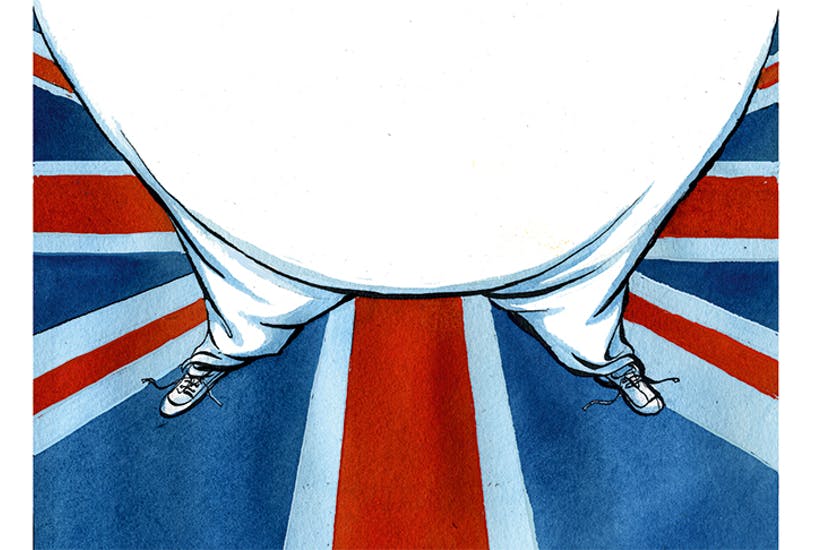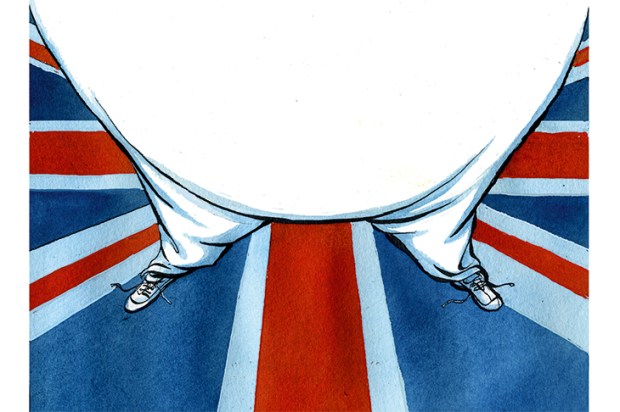The good news is that Theresa May has dropped the threat to withdraw universal free school meals. Thank God (and the PM) for that. School lunches are the biggest weapon we have to fight obesity.
The UK is sixth in the supersize race of OECD countries, with a quarter of the population obese. The fact that six of the fattest nations (the US, Australia, New Zealand, Canada, Ireland and the UK) are English-speaking should tell us something about our food culture. But sadly even Japan and South Korea, the slimmest nations, are fattening up fast on burgers and chips.
What is to be done? No country is going to have the courage to ban junk food, as they have drugs. Maybe we’ll come to that one day. We all know the NHS spends billions on diet-related illnesses, but did you know the fastest-growing surgical procedure in British hospitals is amputations, of which about half are due to diabetes? Can we afford the luxury of obesity? Seriously overweight people are generally less productive and consequently contribute less to the taxman. As important as the drain on the country’s coffers is the sad fact that they are, on average, unhappier and shorter-lived than slim people.
There is a horrible conundrum here. You could argue — and behind closed doors I assume government statisticians must — that obesity actually saves us money, because if we all stayed healthy we’d live longer and cost the country more in pensions and old-age care. But even if that is true, we should be trying to ensure long and healthy lives, not short, out-of-breath ones. So what to do? Almost everyone has an answer: more exercise; more cooking in schools; more food education; better labelling; higher taxes for unhealthy foods; subsidies for healthy ones; manufacturers obliged to lower sugar, fat or salt levels; free school meals; massive public health campaign. Well, here’s my pennyworth: all of the above, and much more.
A lot of rot is spoken about our guzzling vastly more than we did a generation or two ago. In fact, overall, we’re eating less: in the 1950s the average Brit ate 100 calories more per day than we do now. But back then, just 5 per cent of Britons were overweight. That has now gone up to 63 per cent. This is the obesity paradox: we’re eating less as a fat nation than we did as a slim one.
There’s no mystery behind why people get fat. Consume more calories than you burn, and you put on weight. But our lifestyles have changed: when work meant heaving a load of hay or a barrow load of bricks, when ‘play’ meant climbing a tree or playing sport, when people walked or biked to work and school, and women were down on their knees scrubbing the floor, the nation could consume more calories. The combination of moving more and fighting the cold (keeping warm burns calories faster than running) kept our forebears slim. Our food intake has been falling, but nowhere near fast enough to compensate for centrally heated houses and a sedentary lifestyle. Hence the obesity epidemic.
We aren’t going to go back to manual labour, no cars and unheated houses, so what to do? For adults, the podgy horse has probably all but bolted: almost two-thirds are overweight or obese, and we grown-ups will not be told. Our only hope is the next generation. And there we need to do every-thing we can. Since the responsibility cannot be left to parents, we should start with schools. I used to think if we could teach just one generation of children to eat better, we’d have done it. They would grow up with a preference for a healthy lifestyle, they’d indoctrinate their children and voilà! Problem solved.
But I hadn’t reckoned on the power of the contra-forces: the massive influence of food manufacturers with their genius for peddling the most delicious combinations of fat, sugar and salt; the rise of snacking culture and time spent on screens rather than knees-under-table meals; the lure of a nice warm sofa rather than a run in the rain; the competing pressures on curriculum time in schools; the parsimony of governments with other priorities, and above all with the commendable stuff-that-for-a game-of-soldiers attitude of the British citizen who likes his beer and chips, thanks very much.
I’ve been banging away boringly for 40 years about the dangers of not eating properly, and I’ve seen excellent efforts made by schools and charities. But it is clear that unless the campaigning and the incentives are kept up, a lot of backsliding will go on.
The best example of a government serious about health is probably Finland. When I was chair of the School Food Trust, I went to see for myself what a country holding the world record for heart disease was doing about it. The answer was: a lot. They grasped that the problem was lack of activity, as well as diet. So councils were doing their best to remove obstacles to exercise, providing ‘gym parks’, clearing snowy paths and providing free shoe-clamps to make walking in winter possible for the elderly, organising hiking trips for children to collect lingonberries in the forests, subsidising fresh fruit and veg in shops, and taxing the fattening stuff.
They were rightly proud of their efforts in schools. The central planks of the Finnish policy are free school meals for everyone, and teaching children to eat as part of the curriculum. Lunchtime is a class, though it is expected to deliver its lessons in a relaxing and pleasurable atmosphere. School restaurants (not ‘canteens’, you notice) are light, airy and nice places to be. The food is cooked from scratch in batches so it arrives fresh on the counter.
Lunchtime is used to teach more than just how to eat well. Students learn good manners as well as about other cultures: the week I was there, one school was having an Italian week, with history, art and sports classes all going Italian. That week’s menus were mushroom risotto, pasta alle vongole, pizza, Italian sausage stew (all with salad), cold Italian meats (salami, ham etc) and egges, olives and hot potatoes.
Mealtimes were staggered to eliminate queues, with the children serving themselves, taking as little or as much as they liked, and eating it all. No pudding. They had milk or water to drink. Every child did a week’s work experience in the kitchen, and took turns in laying the table and clearing up.
There was no choice (other than for special diets), but the menu changed daily, on a six-to-eight-week cycle. The arguments for a no-choice but changing menu are logical: children are very conservative — given a choice they’ll eat what they know they like. The no-choice menu ensures they taste new things. British school caterers often boast about the variety they offer, but they fail to mention that the majority of children eat pizza every day. If there is no choice, and the culture is to eat what you are given, a hesitant child will at least give it a go.
I said to our guide, an official from the Finnish Department of Education, ‘OK, so everyone eats these school lunches. Of course they do. They aren’t allowed to bring food into school. They’ve no option.’ So he took us to a university college, where 12,000 students ate in huge canteens. Down the middle of the dining rooms were counters serving stews, pastas, salads etc. At the edge of the room, a few students were buying from international franchise stalls, McDonald’s, Starbucks, Dunkin’ Donuts. But far more were crowded round the central counters. ‘They’ve learnt to like healthy food at school,’ said my host. ‘They know it’s good for them. And it’s subsidised, which the junk is not.’
So has Finland cracked the problem? Sadly not. I was there ten years ago, but then the government lifted its foot from the pedal. Vending machines are back in schools, and the population are increasingly taking to eating fattening snacks. Obesity started to rise again and the government has realised that there is no option but to keep up the pressure. Now there are places doing remarkably well again: google ‘WHO Finland-curbs-childhood-obesity’ for one council’s solution.
Part of the UK’s problem is that we see government intervention as nannying. I once tried to get Michael Gove to make learning to eat part of the school curriculum so that teachers would take it seriously. He said that the Tory party believed in choice, in parental responsibility, in the individual being accountable for his or her actions. And I agree: in an ideal world, a free society can’t stop people doing what’s bad for them. You can’t close down Cadbury’s because some people eat too much chocolate.
But damn it, we don’t let parents decide what’s on the maths curriculum. And since the state must pick up the bill for ill health, I think it has every right to insist on education to limit the risk. Given how many obese adults started out as obese children, being serious about tackling obesity must mean landing schools with some of the responsibility. By the time children finish primary school, those from the poorest households are now twice as likely to be obese as the richest. Plainly, obesity is not just about what food people can afford — it’s about habit.
Since the parents’ diet tends to be part of the problem, the best way to tackle this is in the classroom. I don’t think there is a parent or a child in the country who doesn’t know that green veg is better for you than chips. The problem is, they don’t like the taste, and the only way to get to like it is by trying it repeatedly. Schools signed up to the Soil Association’s Food for Life programme know that children can be taught to love vegetables — and the best way is to have them grow it, cook it and eat it.
It’s not the only way. As Finland has discovered, if adults are to make the right choices, it needs to be made easy for them. We need enough sporting facilities, green spaces and playgrounds, for grown-ups as well as children. And fresh food needs to be available, affordable and accessible as well as desirable. It’s no good convincing someone that veg is healthy and delicious if there isn’t a bus to the supermarket and the corner shop on the estate only stocks tins.
Matrons or health visitors should be reintroduced in schools to monitor every child’s progress. And the health of their pupils must be discussed with parents, who will need to be involved in any plans to slim down their children if they are overweight.
All of which means getting the Departments of Education, Health, Environment and Sport to work together, and the Treasury to cough up a shedload of money. What chance of that?
Got something to add? Join the discussion and comment below.
Get 10 issues for just $10
Subscribe to The Spectator Australia today for the next 10 magazine issues, plus full online access, for just $10.
You might disagree with half of it, but you’ll enjoy reading all of it. Try your first month for free, then just $2 a week for the remainder of your first year.














Comments
Don't miss out
Join the conversation with other Spectator Australia readers. Subscribe to leave a comment.
SUBSCRIBEAlready a subscriber? Log in